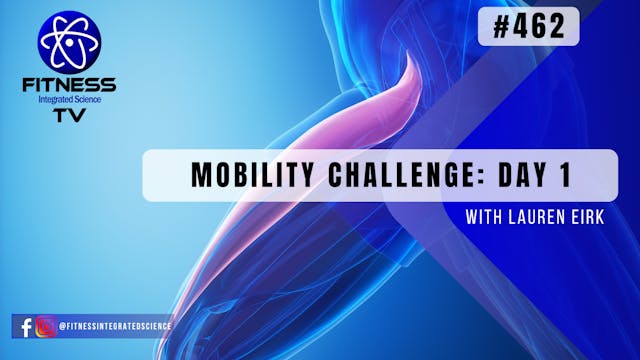Video 463 | Mobility Challenge: Day 2 (30 minutes) with Lauren Eirk
30 Minutes
•
12-Sep-2023
On Day 2 of the mobility series, we will look to strengthen hip flexion, knee extension, ankle dorsiflexion on the way down into the hip hinge, then hip extension, knee extension, and ankle plantar flexion on the way up. Within this, we also look at the spine's involvement in the hip hinge.
We begin by exploring our ability to move from spine to activate muscles of the core. Next we will practice some hip and trunk flexion isometrics from a supine and seated position. Since the hamstrings' role in a hip hinge is largely eccentric, we will train the hamstrings the very same way to enhance mobility.
Notice how much more range you now have when you come to standing! As we practice a bodyweight hip hinge, you will experience first-hand why the isometrics help. See how hip flexion feels from a standing position as we continuously practice our range in the hip hinge. We will look at wide-leg, staggered, and parallel versions. I am intentionally moving slowly in a controlled manner. Feel free to try this without dumbbells if it is too much!
As we check our final hip hinge range of motion evaluation, notice the quality and range of motion you have, being mindful of your form. Regular practice of this mobility workout will help you move better with more speed and efficiency.
Keep in mind that there are many things that affect our hip hinge ability such as:
1. The length of our levers: torso length vs. that of the legs.
2. The placement and amount of any external loads
3. Our ability to perform on a given day
4. The ability our muscles have to work to shorten to create the hip hinge, as well as eccentrically allow for the shortening to stabilize the joint.
5. The amount of motion we have available at any of the involved joints.
6. The position of our lower body of the forward bend. (ie: wide, narrow, staggered, knees flexed, knees extended)
7. The plane of motion we are moving through and whether or not our joints can do this efficiently (Sagittal plane hip flexion).
8. The ability of our core to be able to stabilize enough to perform the exercise (extension).
The hip hinge is a foundational movement. I mean, think of how many times you bend over each and every day? How many times do you bend over each and every day?
Every one of us performs the hip hinge movement many times throughout our daily lives. Whether it be simply picking up an object off the floor or getting dressed and tying your shoes– we are performing this primal movement pattern whether we know it or not.
That’s why mastering this foundational human movement pattern is so important. Training to be able to hinge from the hip is vital, as it protects us from injury and helps us perform better in our activities. Humans need to be able to bend at the hip while maintaining a strong core, neutral spine, and stable lower body. In the exercise world, we call them "deadlifts". They are similar to the squat, but the knee is not flexing very much, if at all.
There are many people who will tell you to avoid this motion at all costs, since the lower back is a big player. However any exercise can have higher risk with added loads, greater joint ranges, and added speed. This is why we need to learn this in a slow, controlled manner with bodyweight only. The blocks help raise the floor enough to engage the upper body and keep muscles under tension. There are many types of forward bends, such as the Bodyweight Good Morning, Romanian Deadlift, Med Ball Deadlift, Barbell Deadlift, Clean, Staggered Deadlift, Single Leg Deadlift, and Sumo Deadlift. While the deadlift is certainly a hinge, the hinge pattern encapsulates a greater range of movements. Instead of avoiding the movement because of a fear of something intimidating like the deadlift, we should learn the movement first in an unloaded environment like you have here on the FIS TV Mobility Challenge.
Purchase the equipment used in this video from Amazon:
Neoprene Coated Dumbbells: https://amzn.to/3OCSr28
Yoga Block: https://amzn.to/3ewJAJK
Yoga Mat: https://amzn.to/2ZDSMrH
mc_13
Up Next in 30 Minutes
-
Video 462 | Mobility Challenge: Day 1...
On day 1 of the mobility series, we will look to strengthen hip flexion, knee flexion, ankle dorsiflexion on the way down to the squat, then hip extension, knee extension, and ankle plantar flexion on the way up. Within this, we also look at the spine's involvement in the squat.
We begin by exp...
-
Video 461 | Yoga Chair Shoulder Mobil...
Yoga itself is an isometric practice using the principles of resistance training. Postures, or "asanas", are used in Yoga to create maximum health in the body for improved concentration and control. In this practice, the focus is to improve the integrity of the shoulder joint.
Using a chair as ...
-
Video 460 | Pilates Lean Legs (30 min...
This workout showcases many of the classic Pilates mat exercises that target the lower body using nothing but bodyweight, high reps, and high effort in order to hypertrophy and "tone" the legs.
We will start with a standing warm-up, then move to the floor for several sidelying hip exercises. ...




8 Comments